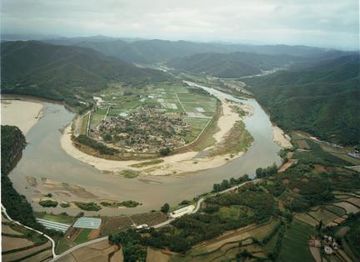안동 하회마을
| 안동 하회마을 Hahoe Village, Andong |
|
 안동 하회마을, 국가문화유산포털, 문화재청. |
|
| 대표명칭 | 안동 하회마을 |
|---|---|
| 영문명칭 | Hahoe Village, Andong |
| 한자 | 安東 河回마을 |
| 주소 | 경상북도 안동시 풍천면 하회리 |
| 지정(등록) 종목 | 국가민속문화재 제122호 |
| 지정(등록)일 | 1984년 1월 14일 |
| 분류 | 유적건조물/주거생활/주거건축/마을 |
| 시대 | 조선시대 |
| 수량/면적 | 1,577필지/6,495,535㎡ |
| 웹사이트 | 안동 하회마을, 국가문화유산포털, 문화재청. |
|
|
|
해설문
기존 국문
이 마을은 풍산류씨가 600여 년간 대대로 살아온 한국의 대표적인 동성마을이며, 와가와 초가가 오랜 역사 속에서도 잘 보존된 곳이다. 특히 조선시대 대유학자인 류운룡과 임진왜란 때 영의정을 지낸 류성룡 형제가 태어난 곳으로도 유명하다.
마을 이름을 하회(河回)라고 한 것은 낙동강이 ‘S’자 모양으로 마을을 감싸 안고 흐르는 데서 유래되었다. 하회마을은 형국상으로 태극형‧연화부수형‧행주형에 해당하며, 이미 조선시대부터 사람이 살기에 가장 좋은 곳으로도 유명하였다. 마을의 동쪽에 태백산에서 뻗어 나온 해발 327m의 화산(花山)이 있고, 이 화산의 줄기가 낮은 구릉지를 형성하면서 마을의 서쪽 끝까지 뻗어있으며, 수령이 600여 년 된 삼신당 느티나무가 있는 지역이 마을에서 가장 높은 중심부에 해당한다.
하회마을의 집들은 삼신당 느티나무를 중심으로 강을 향해 배치되어 있기 때문에 좌향이 일정하지 않다. 한국의 다른 마을들의 집들이 정남향 또는 동남향을 하고 있는 것과는 상당히 대조적인 모습이다. 또한 큰 와가를 중심으로 주변의 초가들이 원형을 이루며 배치되어 있는 것도 특징이라 하겠다.
하회마을에는 서민들의 놀이인 ‘하회별신굿탈놀이’와 선비들의 풍류놀이인 ‘선유줄불놀이’가 현재까지도 온전히 전승되고 있고, 우리나라의 전통생활 문화와 고건축양식을 잘 보여주는 문화유산들이 잘 보존되어 있다.
수정 국문
하회라는 마을 이름은 물이 돌아 흐른다는 뜻을 담고 있다. 낙동강 상류인 화천이 ‘S’자 모양으로 마을을 감싸 안고 흐르는 데서 생겨났다. 태극 모양 혹은 연꽃이 물에 떠 있는 형상으로 예로부터 좋은 땅으로 여겨지는 곳이다.
이 마을은 한국의 대표적인 씨족 마을로, 고려 중기에 김해허씨와 광주안씨, 14세기 고려 말에 풍산류씨가 들어와 마을을 이루었다. 이후 풍산류씨를 중심으로 마을이 번성하였으며, 특히 조선시대의 문신 학자인 류운룡과 류성룡 형제가 태어난 곳으로 유명하다.
하회마을에는 우리나라의 고건축 양식과 전통적인 생활 모습을 보여주는 문화유산들이 잘 보존되어 있다. 류씨 문중의 고택에서는 조선시대 양반가의 전통과 의례가 유지되고 있으며, 마을 주민들은 ‘하회별신굿탈놀이’, ‘선유줄불놀이’ 등 서민과 선비들의 공동체놀이를 현재까지도 온전히 전승하고 있다. 하회마을은 자연과 조화를 이루는 살아있는 문화유산으로서의 가치를 인정받아 2010년 유네스코 세계문화유산으로 지정되었다.
영문
Hahoe Village is one of the representative clan villages in Korea. This village is comprised of 127 houses built in the traditional Korean style, among them twelve are designated as national and provincial cultural heritage. The residences of the upper class, pavilions, study halls, Confucian academies, and thatched-roofed houses of commoners are well maintained. Villagers perform traditional rituals and customs of the Joseon period (1392-1910) until today. For these reasons, Hahoe Village was inscribed on the UNESCO World Heritage List in 2010.
The village was created when the Gimhae Heo clan and the Gwangju An clan moved to this area in the middle period of Goryeo dynasty (918-1392). Later, the Punsan Ryu clan came to settle here in the late 14th century. This village thrived as the Punsan Ryu clan obtained prestige by the esteemed scholar officials Ryu Un-ryong (1539-1601) and his brother Seong-ryong (1542-1607) who were born in this village. The Ryu clan has built study halls and Confucian academies in the neighborhood over time to promote education. During Joseon period, a clan was established by a patriarch and was comprised of its descendants. The primary lineage of first-born male descendants, called the "head family," would live in the clan village, which would serve as a home base for the clan's Confucian education and ancestral rituals.
The village nestled in a bend of the river, called Hwacheon, the upstream of Nakdonggang river. Its name “Hahoe” literally means “encircled by river.” The river flows around the perimeter of the village, making it look like the shape of taegeuk, the symbol of harmony of yin and yang, or a lotus flower in a pond. The lay of the land has long been regarded as auspicious. The villagers have preserved the mask play called “Byeolsin gut talnori,” (Intangible Heritage No. 69), which is eight-scene play with sarcasm mocking the upper class and monks. Another tradition is “Julbul Nori,” which used strings of fireworks at the Buyongdae cliff under which scholars wrote poems on boats in the river with small fireworks lit in eggshells floating in the water.
Other important cultural heritage of this village includes Hahoe masks (National Treasure No.121) and Jingbirok, the records of Imjin war (1592-1598) written by Ryu Seong-ryong (National Treasure No.132).